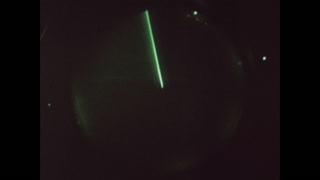This U.S. Air Force film “Progress in Air Traffic Control” dates to 1973. The film reviews the history of air traffic control and depicts modern techniques and automated systems in operation. It also describes plans for improved control in the future and for the conservation of air space to handle air traffic increases. From an historic perspective, the film shows improvements based on the 1961 Project Beacon task force, which urged substantial improvements to meet the future challenge of aviation’s projected growth.
The film begins with a view of a plane taking off from a runway (0:41). A passenger hands identification to a gate agent at a Pan American ticket counter (0:45). Close up of the turbines of a Pan American plane (0:58); passengers board the plane. “No Smoking” and “Fasten Seat Belt” signs (1:12). The pilot speaks into a handheld receiver headset to communicate with air traffic control (1:28); he engages the throttle and the plane takes off. Three U.S. Navy F-4 Phantoms (2:02); a Boeing 707 (2:06); a Braniff plane (2:46). Cartoon pilots as narrator asks the central question: “How has the control of traffic in the air improved since the good old days?” (2:57). It explains that early flight traffic was controlled by visual flight rules (VFR), but commercial and military aircraft led to faster speeds and the need for air traffic control. Animation of two jets at 600 mph (3:40) explaining why in-flight rule (IFR) conditions and radar are needed. Animation explaining how radar, developed in World War II for military use, (4:09), and transponders, which strengthen signals, (5:07), work. Animation of different transponder modes; 3A is the mode used in air traffic control (5:32). Animation shows how since mode 3A only has 64 codes, air traffic control can identify specific aircraft (6:26). Air traffic controllers at a Federal Aviation Agency (FAA) control center examine radar and communicate with pilots (7:02), moving plastic “shrimp boats” to identify aircraft. A controller gives instructions to an Air Force pilot (8:40); the plane’s descent is shown on radar and communications equipment (9:06). View from the plane as it lands on the runway (10:07). Animation showing elevation for military and civil aircraft (10:35); flights above 24,000 feet must have transponders and flight plans, known as “positive control”. Animation showing criteria for controlled aircraft (11:18): vertical spacing, time spacing, and horizontal spacing. At 12:17, an FAA report for Project Beacon, a task force to study future safe and efficient use of airspace. Animation shows Project Beacon recommendations (12:30): that positive control extend to 14,500 feet away from sea level and mountains and down to 8,000 feet on congested airways. Controllers work on early computers (13:00); Project Beacon recommended that computers be used to handle flight plans and voice control between controllers and pilots should be reduced. A Memorandum of Understanding between the FAA and Department of Defense (DOD) (13:38); after Project Beacon, national standards were revised to develop a national airspace system (NAS) and put recommendations in place. The DOD developed the AIMS system (14:22) to reduce voice communication and develop new equipment. Animation shows how better transponders with 4,096 codes will have better capabilities (15:45). Alphanumeric characters on an air traffic control scope display (16:19), which eliminate the need for ”shrimp boats.” The film ends showing a family on a Pan Am plane as it takes off (17:45); narration emphasizes the safety of air travel due to radar and continuing development of air traffic control systems. Credits: Produced by Aerospace Audio-Visual Service Military Aircraft Command under the supervision of the United States Air Force with the cooperation of the U.S. Army and U.S. Navy; coordinated with Federal Aviation Agency. Bay State Film Productions, Inc.
Motion picture films don’t last forever; many have already been lost or destroyed. For almost two decades, we’ve worked to collect, scan and preserve the world as it was captured on 35mm, 16mm and 8mm movies — including home movies, industrial films, and other non-fiction. If you have endangered films you’d like to have scanned, or wish to donate celluloid to Periscope Film so that we can share them with the world, we’d love to hear from you. Contact us via the weblink below.
This film is part of the Periscope Film LLC archive, one of the largest historic military, transportation, and aviation stock footage collections in the USA. Entirely film backed, this material is available for licensing in 24p HD, 2k and 4k. For more information visit http://www.PeriscopeFilm.com


